Oil & Gas Retail Industry Development
VerifiedAdded on 2020/02/03
|9
|2651
|70
Report
AI Summary
This report provides a comprehensive analysis of the development of the oil and gas retail industry in the UK. It examines the historical evolution of the petroleum supply chain, highlighting key changes in the downstream sector. The report details the different ownership structures and the changing number of petrol filling stations, particularly the rise of hypermarkets. Customer behavior and responses to price and safety concerns are discussed, along with the significant impact of technological advancements on exploration, extraction, production, refining, environmental protection, and distribution efficiency. The conclusion summarizes the substantial growth and development within the industry, emphasizing increased accessibility, eco-friendliness, and productivity.
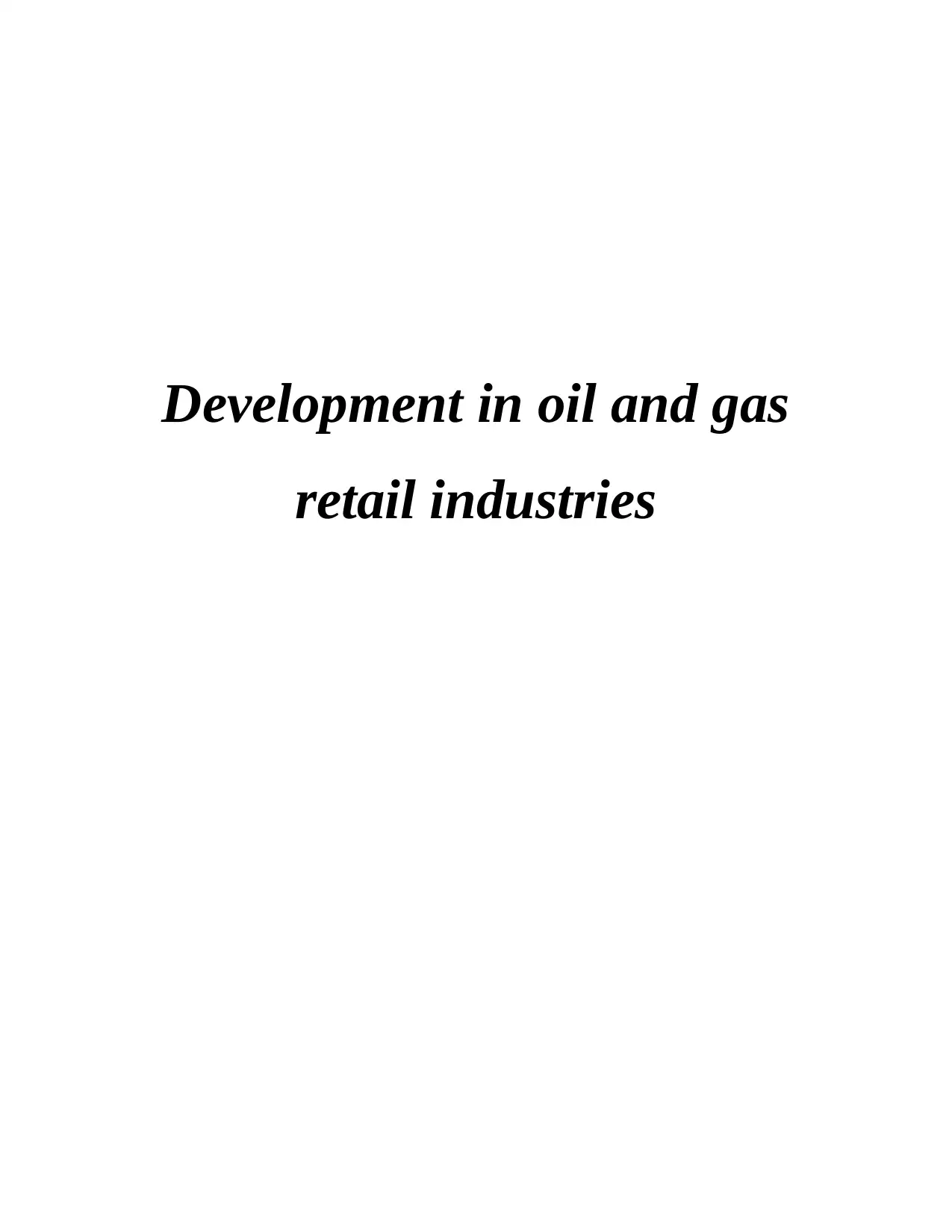
Development in oil and gas
retail industries
retail industries
Paraphrase This Document
Need a fresh take? Get an instant paraphrase of this document with our AI Paraphraser
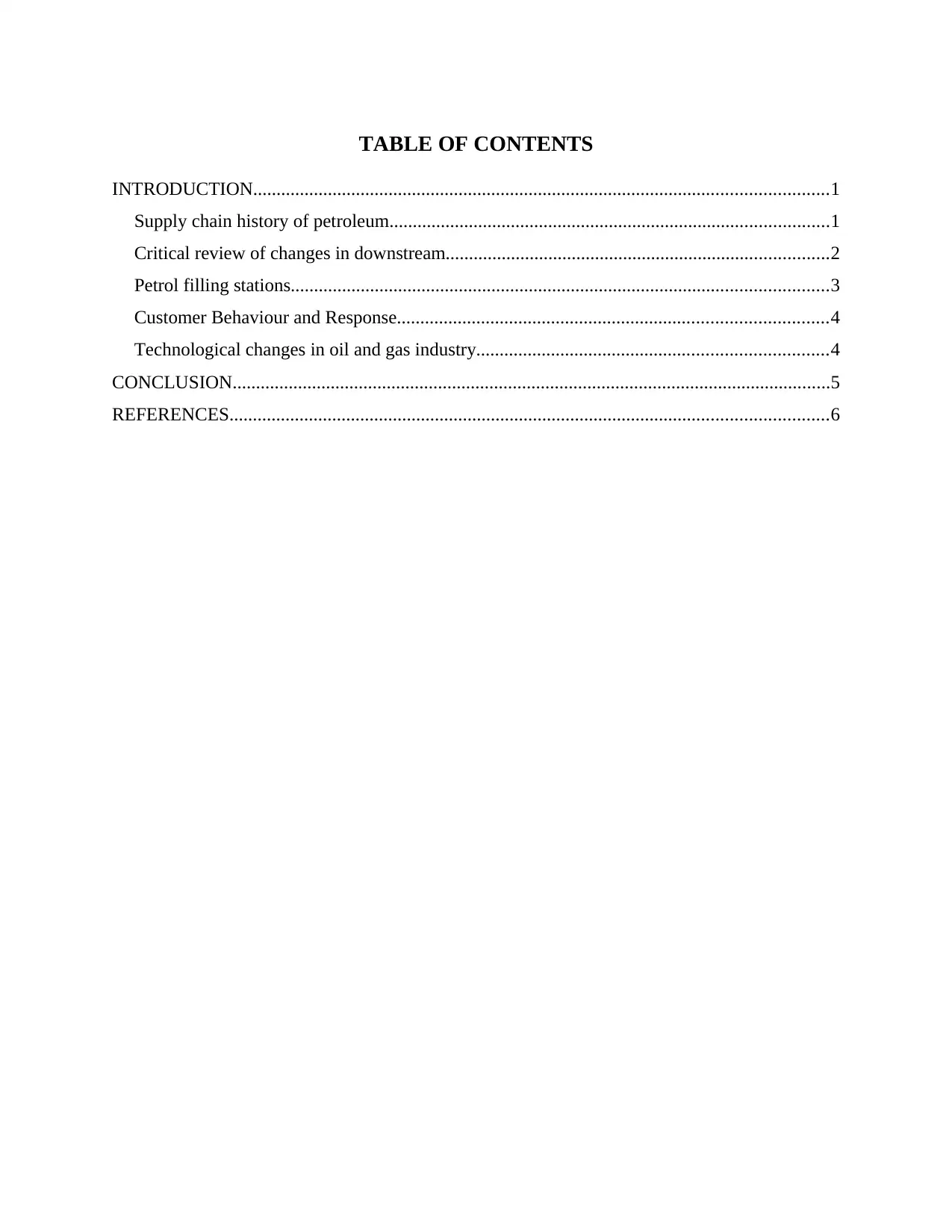
TABLE OF CONTENTS
INTRODUCTION...........................................................................................................................1
Supply chain history of petroleum..............................................................................................1
Critical review of changes in downstream..................................................................................2
Petrol filling stations...................................................................................................................3
Customer Behaviour and Response............................................................................................4
Technological changes in oil and gas industry...........................................................................4
CONCLUSION................................................................................................................................5
REFERENCES................................................................................................................................6
INTRODUCTION...........................................................................................................................1
Supply chain history of petroleum..............................................................................................1
Critical review of changes in downstream..................................................................................2
Petrol filling stations...................................................................................................................3
Customer Behaviour and Response............................................................................................4
Technological changes in oil and gas industry...........................................................................4
CONCLUSION................................................................................................................................5
REFERENCES................................................................................................................................6

⊘ This is a preview!⊘
Do you want full access?
Subscribe today to unlock all pages.

Trusted by 1+ million students worldwide
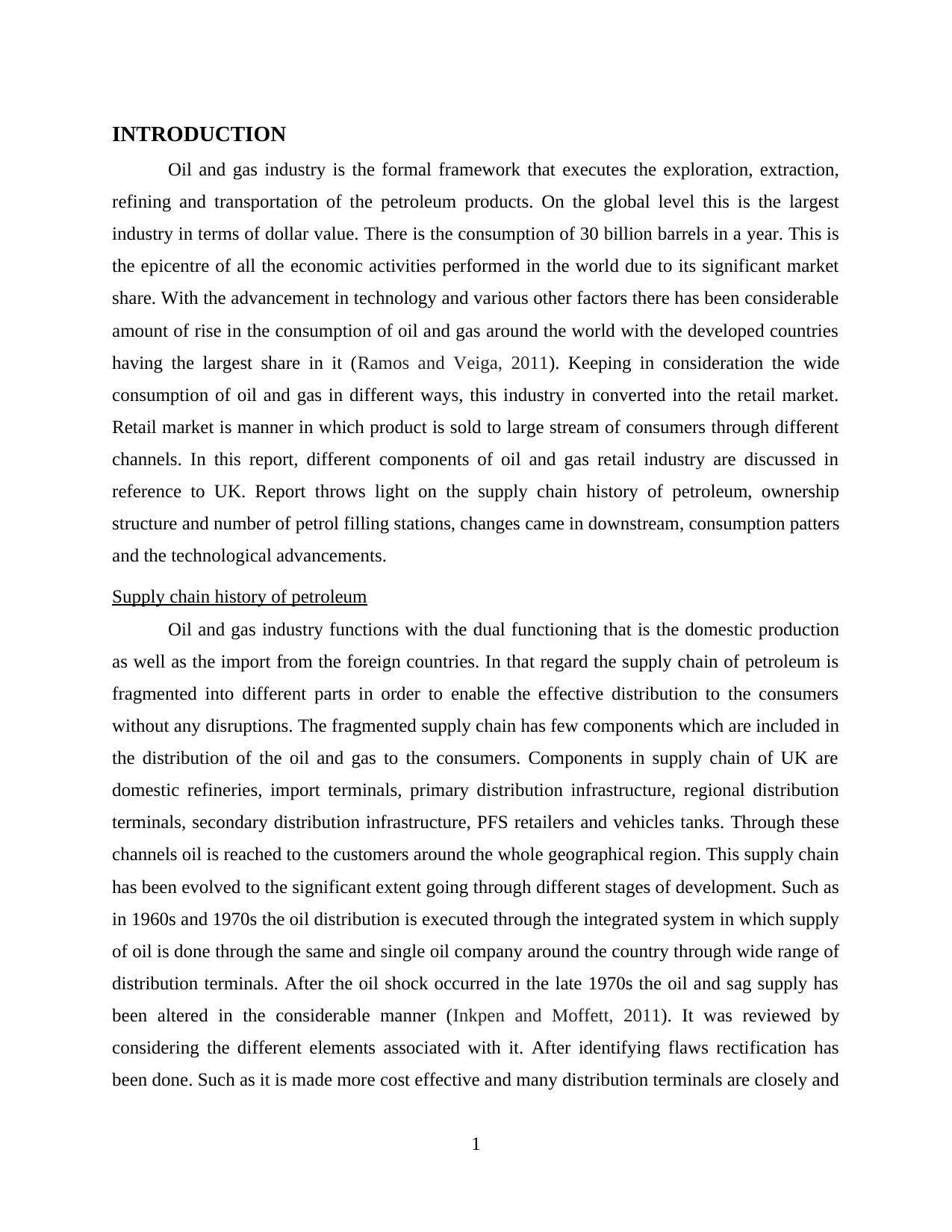
INTRODUCTION
Oil and gas industry is the formal framework that executes the exploration, extraction,
refining and transportation of the petroleum products. On the global level this is the largest
industry in terms of dollar value. There is the consumption of 30 billion barrels in a year. This is
the epicentre of all the economic activities performed in the world due to its significant market
share. With the advancement in technology and various other factors there has been considerable
amount of rise in the consumption of oil and gas around the world with the developed countries
having the largest share in it (Ramos and Veiga, 2011). Keeping in consideration the wide
consumption of oil and gas in different ways, this industry in converted into the retail market.
Retail market is manner in which product is sold to large stream of consumers through different
channels. In this report, different components of oil and gas retail industry are discussed in
reference to UK. Report throws light on the supply chain history of petroleum, ownership
structure and number of petrol filling stations, changes came in downstream, consumption patters
and the technological advancements.
Supply chain history of petroleum
Oil and gas industry functions with the dual functioning that is the domestic production
as well as the import from the foreign countries. In that regard the supply chain of petroleum is
fragmented into different parts in order to enable the effective distribution to the consumers
without any disruptions. The fragmented supply chain has few components which are included in
the distribution of the oil and gas to the consumers. Components in supply chain of UK are
domestic refineries, import terminals, primary distribution infrastructure, regional distribution
terminals, secondary distribution infrastructure, PFS retailers and vehicles tanks. Through these
channels oil is reached to the customers around the whole geographical region. This supply chain
has been evolved to the significant extent going through different stages of development. Such as
in 1960s and 1970s the oil distribution is executed through the integrated system in which supply
of oil is done through the same and single oil company around the country through wide range of
distribution terminals. After the oil shock occurred in the late 1970s the oil and sag supply has
been altered in the considerable manner (Inkpen and Moffett, 2011). It was reviewed by
considering the different elements associated with it. After identifying flaws rectification has
been done. Such as it is made more cost effective and many distribution terminals are closely and
1
Oil and gas industry is the formal framework that executes the exploration, extraction,
refining and transportation of the petroleum products. On the global level this is the largest
industry in terms of dollar value. There is the consumption of 30 billion barrels in a year. This is
the epicentre of all the economic activities performed in the world due to its significant market
share. With the advancement in technology and various other factors there has been considerable
amount of rise in the consumption of oil and gas around the world with the developed countries
having the largest share in it (Ramos and Veiga, 2011). Keeping in consideration the wide
consumption of oil and gas in different ways, this industry in converted into the retail market.
Retail market is manner in which product is sold to large stream of consumers through different
channels. In this report, different components of oil and gas retail industry are discussed in
reference to UK. Report throws light on the supply chain history of petroleum, ownership
structure and number of petrol filling stations, changes came in downstream, consumption patters
and the technological advancements.
Supply chain history of petroleum
Oil and gas industry functions with the dual functioning that is the domestic production
as well as the import from the foreign countries. In that regard the supply chain of petroleum is
fragmented into different parts in order to enable the effective distribution to the consumers
without any disruptions. The fragmented supply chain has few components which are included in
the distribution of the oil and gas to the consumers. Components in supply chain of UK are
domestic refineries, import terminals, primary distribution infrastructure, regional distribution
terminals, secondary distribution infrastructure, PFS retailers and vehicles tanks. Through these
channels oil is reached to the customers around the whole geographical region. This supply chain
has been evolved to the significant extent going through different stages of development. Such as
in 1960s and 1970s the oil distribution is executed through the integrated system in which supply
of oil is done through the same and single oil company around the country through wide range of
distribution terminals. After the oil shock occurred in the late 1970s the oil and sag supply has
been altered in the considerable manner (Inkpen and Moffett, 2011). It was reviewed by
considering the different elements associated with it. After identifying flaws rectification has
been done. Such as it is made more cost effective and many distribution terminals are closely and
1
Paraphrase This Document
Need a fresh take? Get an instant paraphrase of this document with our AI Paraphraser
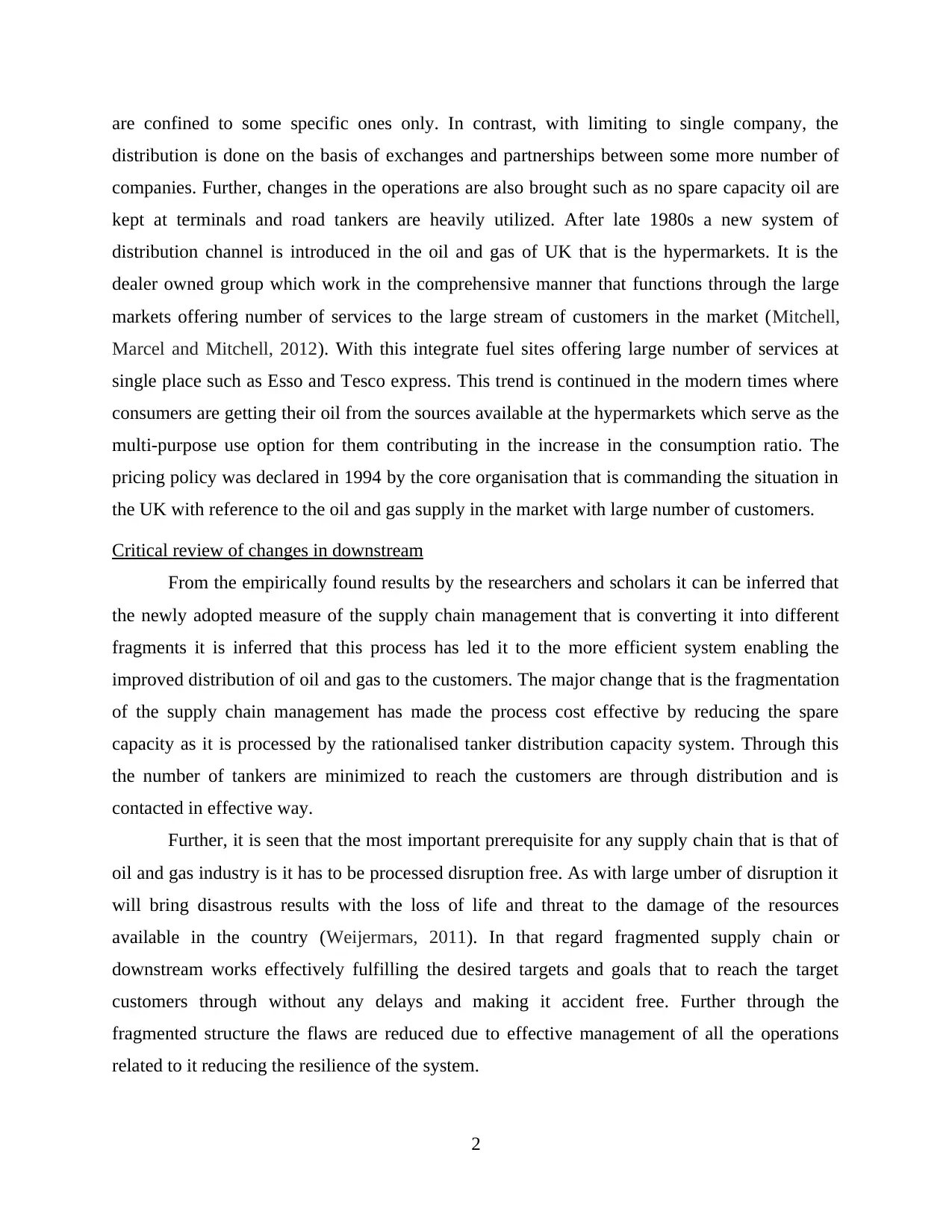
are confined to some specific ones only. In contrast, with limiting to single company, the
distribution is done on the basis of exchanges and partnerships between some more number of
companies. Further, changes in the operations are also brought such as no spare capacity oil are
kept at terminals and road tankers are heavily utilized. After late 1980s a new system of
distribution channel is introduced in the oil and gas of UK that is the hypermarkets. It is the
dealer owned group which work in the comprehensive manner that functions through the large
markets offering number of services to the large stream of customers in the market (Mitchell,
Marcel and Mitchell, 2012). With this integrate fuel sites offering large number of services at
single place such as Esso and Tesco express. This trend is continued in the modern times where
consumers are getting their oil from the sources available at the hypermarkets which serve as the
multi-purpose use option for them contributing in the increase in the consumption ratio. The
pricing policy was declared in 1994 by the core organisation that is commanding the situation in
the UK with reference to the oil and gas supply in the market with large number of customers.
Critical review of changes in downstream
From the empirically found results by the researchers and scholars it can be inferred that
the newly adopted measure of the supply chain management that is converting it into different
fragments it is inferred that this process has led it to the more efficient system enabling the
improved distribution of oil and gas to the customers. The major change that is the fragmentation
of the supply chain management has made the process cost effective by reducing the spare
capacity as it is processed by the rationalised tanker distribution capacity system. Through this
the number of tankers are minimized to reach the customers are through distribution and is
contacted in effective way.
Further, it is seen that the most important prerequisite for any supply chain that is that of
oil and gas industry is it has to be processed disruption free. As with large umber of disruption it
will bring disastrous results with the loss of life and threat to the damage of the resources
available in the country (Weijermars, 2011). In that regard fragmented supply chain or
downstream works effectively fulfilling the desired targets and goals that to reach the target
customers through without any delays and making it accident free. Further through the
fragmented structure the flaws are reduced due to effective management of all the operations
related to it reducing the resilience of the system.
2
distribution is done on the basis of exchanges and partnerships between some more number of
companies. Further, changes in the operations are also brought such as no spare capacity oil are
kept at terminals and road tankers are heavily utilized. After late 1980s a new system of
distribution channel is introduced in the oil and gas of UK that is the hypermarkets. It is the
dealer owned group which work in the comprehensive manner that functions through the large
markets offering number of services to the large stream of customers in the market (Mitchell,
Marcel and Mitchell, 2012). With this integrate fuel sites offering large number of services at
single place such as Esso and Tesco express. This trend is continued in the modern times where
consumers are getting their oil from the sources available at the hypermarkets which serve as the
multi-purpose use option for them contributing in the increase in the consumption ratio. The
pricing policy was declared in 1994 by the core organisation that is commanding the situation in
the UK with reference to the oil and gas supply in the market with large number of customers.
Critical review of changes in downstream
From the empirically found results by the researchers and scholars it can be inferred that
the newly adopted measure of the supply chain management that is converting it into different
fragments it is inferred that this process has led it to the more efficient system enabling the
improved distribution of oil and gas to the customers. The major change that is the fragmentation
of the supply chain management has made the process cost effective by reducing the spare
capacity as it is processed by the rationalised tanker distribution capacity system. Through this
the number of tankers are minimized to reach the customers are through distribution and is
contacted in effective way.
Further, it is seen that the most important prerequisite for any supply chain that is that of
oil and gas industry is it has to be processed disruption free. As with large umber of disruption it
will bring disastrous results with the loss of life and threat to the damage of the resources
available in the country (Weijermars, 2011). In that regard fragmented supply chain or
downstream works effectively fulfilling the desired targets and goals that to reach the target
customers through without any delays and making it accident free. Further through the
fragmented structure the flaws are reduced due to effective management of all the operations
related to it reducing the resilience of the system.
2
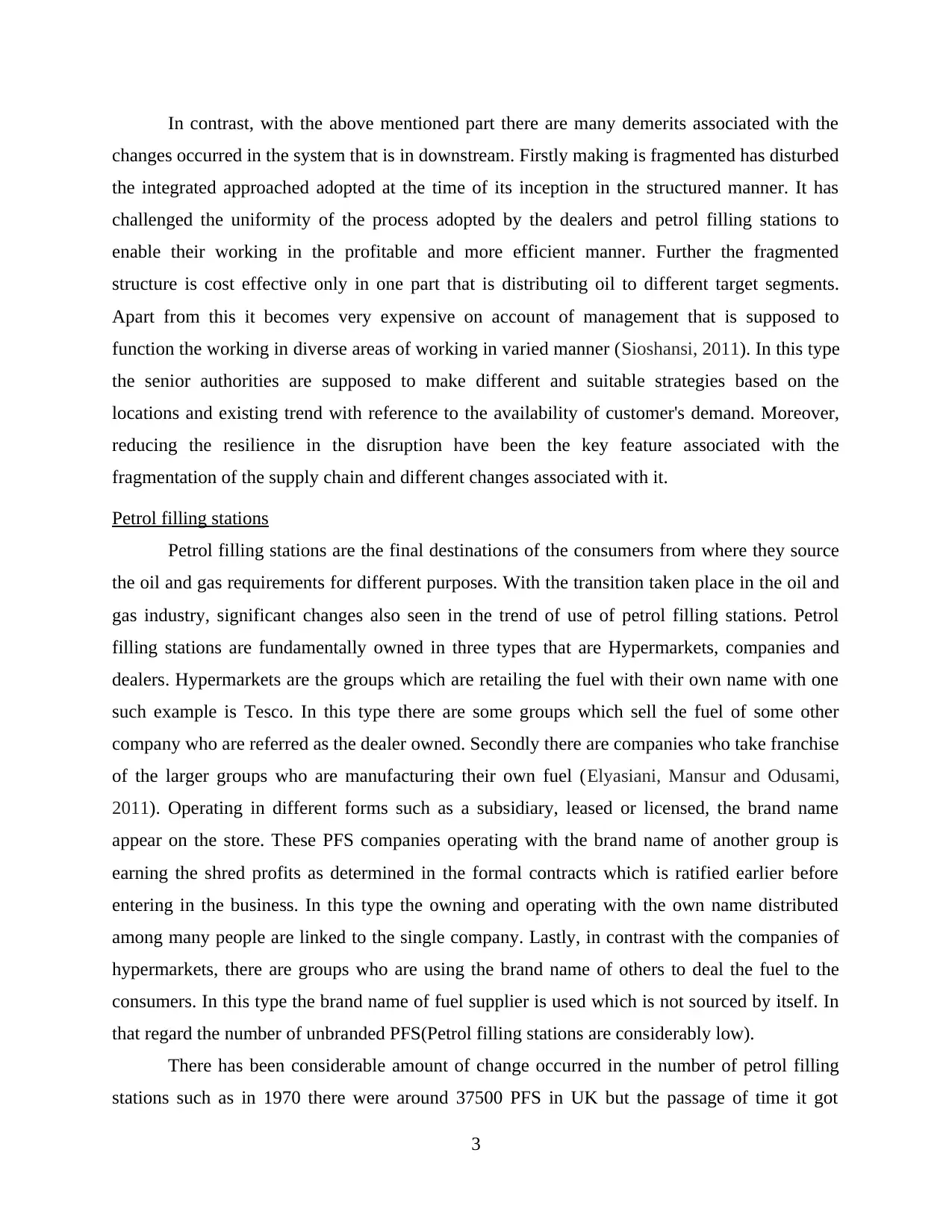
In contrast, with the above mentioned part there are many demerits associated with the
changes occurred in the system that is in downstream. Firstly making is fragmented has disturbed
the integrated approached adopted at the time of its inception in the structured manner. It has
challenged the uniformity of the process adopted by the dealers and petrol filling stations to
enable their working in the profitable and more efficient manner. Further the fragmented
structure is cost effective only in one part that is distributing oil to different target segments.
Apart from this it becomes very expensive on account of management that is supposed to
function the working in diverse areas of working in varied manner (Sioshansi, 2011). In this type
the senior authorities are supposed to make different and suitable strategies based on the
locations and existing trend with reference to the availability of customer's demand. Moreover,
reducing the resilience in the disruption have been the key feature associated with the
fragmentation of the supply chain and different changes associated with it.
Petrol filling stations
Petrol filling stations are the final destinations of the consumers from where they source
the oil and gas requirements for different purposes. With the transition taken place in the oil and
gas industry, significant changes also seen in the trend of use of petrol filling stations. Petrol
filling stations are fundamentally owned in three types that are Hypermarkets, companies and
dealers. Hypermarkets are the groups which are retailing the fuel with their own name with one
such example is Tesco. In this type there are some groups which sell the fuel of some other
company who are referred as the dealer owned. Secondly there are companies who take franchise
of the larger groups who are manufacturing their own fuel (Elyasiani, Mansur and Odusami,
2011). Operating in different forms such as a subsidiary, leased or licensed, the brand name
appear on the store. These PFS companies operating with the brand name of another group is
earning the shred profits as determined in the formal contracts which is ratified earlier before
entering in the business. In this type the owning and operating with the own name distributed
among many people are linked to the single company. Lastly, in contrast with the companies of
hypermarkets, there are groups who are using the brand name of others to deal the fuel to the
consumers. In this type the brand name of fuel supplier is used which is not sourced by itself. In
that regard the number of unbranded PFS(Petrol filling stations are considerably low).
There has been considerable amount of change occurred in the number of petrol filling
stations such as in 1970 there were around 37500 PFS in UK but the passage of time it got
3
changes occurred in the system that is in downstream. Firstly making is fragmented has disturbed
the integrated approached adopted at the time of its inception in the structured manner. It has
challenged the uniformity of the process adopted by the dealers and petrol filling stations to
enable their working in the profitable and more efficient manner. Further the fragmented
structure is cost effective only in one part that is distributing oil to different target segments.
Apart from this it becomes very expensive on account of management that is supposed to
function the working in diverse areas of working in varied manner (Sioshansi, 2011). In this type
the senior authorities are supposed to make different and suitable strategies based on the
locations and existing trend with reference to the availability of customer's demand. Moreover,
reducing the resilience in the disruption have been the key feature associated with the
fragmentation of the supply chain and different changes associated with it.
Petrol filling stations
Petrol filling stations are the final destinations of the consumers from where they source
the oil and gas requirements for different purposes. With the transition taken place in the oil and
gas industry, significant changes also seen in the trend of use of petrol filling stations. Petrol
filling stations are fundamentally owned in three types that are Hypermarkets, companies and
dealers. Hypermarkets are the groups which are retailing the fuel with their own name with one
such example is Tesco. In this type there are some groups which sell the fuel of some other
company who are referred as the dealer owned. Secondly there are companies who take franchise
of the larger groups who are manufacturing their own fuel (Elyasiani, Mansur and Odusami,
2011). Operating in different forms such as a subsidiary, leased or licensed, the brand name
appear on the store. These PFS companies operating with the brand name of another group is
earning the shred profits as determined in the formal contracts which is ratified earlier before
entering in the business. In this type the owning and operating with the own name distributed
among many people are linked to the single company. Lastly, in contrast with the companies of
hypermarkets, there are groups who are using the brand name of others to deal the fuel to the
consumers. In this type the brand name of fuel supplier is used which is not sourced by itself. In
that regard the number of unbranded PFS(Petrol filling stations are considerably low).
There has been considerable amount of change occurred in the number of petrol filling
stations such as in 1970 there were around 37500 PFS in UK but the passage of time it got
3
⊘ This is a preview!⊘
Do you want full access?
Subscribe today to unlock all pages.

Trusted by 1+ million students worldwide
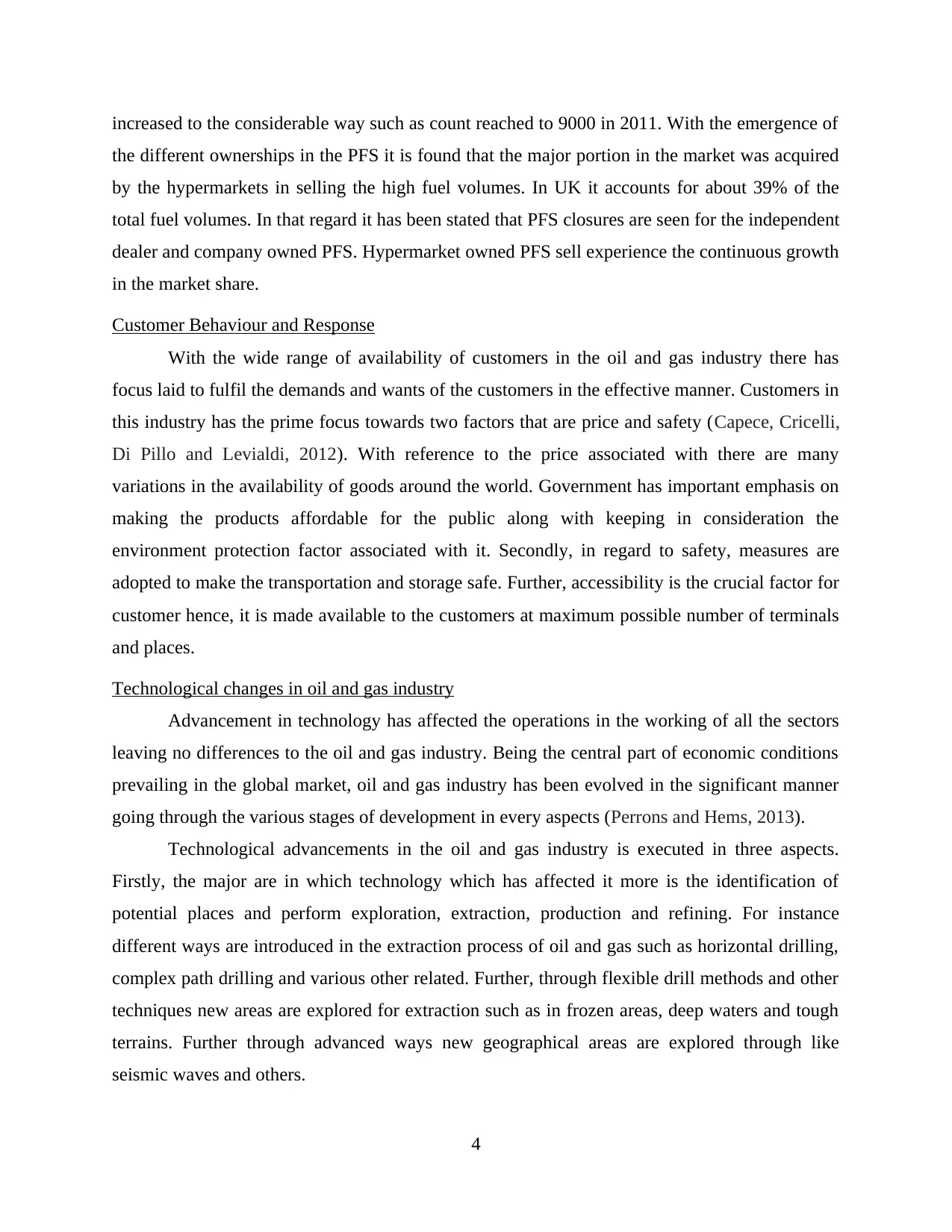
increased to the considerable way such as count reached to 9000 in 2011. With the emergence of
the different ownerships in the PFS it is found that the major portion in the market was acquired
by the hypermarkets in selling the high fuel volumes. In UK it accounts for about 39% of the
total fuel volumes. In that regard it has been stated that PFS closures are seen for the independent
dealer and company owned PFS. Hypermarket owned PFS sell experience the continuous growth
in the market share.
Customer Behaviour and Response
With the wide range of availability of customers in the oil and gas industry there has
focus laid to fulfil the demands and wants of the customers in the effective manner. Customers in
this industry has the prime focus towards two factors that are price and safety (Capece, Cricelli,
Di Pillo and Levialdi, 2012). With reference to the price associated with there are many
variations in the availability of goods around the world. Government has important emphasis on
making the products affordable for the public along with keeping in consideration the
environment protection factor associated with it. Secondly, in regard to safety, measures are
adopted to make the transportation and storage safe. Further, accessibility is the crucial factor for
customer hence, it is made available to the customers at maximum possible number of terminals
and places.
Technological changes in oil and gas industry
Advancement in technology has affected the operations in the working of all the sectors
leaving no differences to the oil and gas industry. Being the central part of economic conditions
prevailing in the global market, oil and gas industry has been evolved in the significant manner
going through the various stages of development in every aspects (Perrons and Hems, 2013).
Technological advancements in the oil and gas industry is executed in three aspects.
Firstly, the major are in which technology which has affected it more is the identification of
potential places and perform exploration, extraction, production and refining. For instance
different ways are introduced in the extraction process of oil and gas such as horizontal drilling,
complex path drilling and various other related. Further, through flexible drill methods and other
techniques new areas are explored for extraction such as in frozen areas, deep waters and tough
terrains. Further through advanced ways new geographical areas are explored through like
seismic waves and others.
4
the different ownerships in the PFS it is found that the major portion in the market was acquired
by the hypermarkets in selling the high fuel volumes. In UK it accounts for about 39% of the
total fuel volumes. In that regard it has been stated that PFS closures are seen for the independent
dealer and company owned PFS. Hypermarket owned PFS sell experience the continuous growth
in the market share.
Customer Behaviour and Response
With the wide range of availability of customers in the oil and gas industry there has
focus laid to fulfil the demands and wants of the customers in the effective manner. Customers in
this industry has the prime focus towards two factors that are price and safety (Capece, Cricelli,
Di Pillo and Levialdi, 2012). With reference to the price associated with there are many
variations in the availability of goods around the world. Government has important emphasis on
making the products affordable for the public along with keeping in consideration the
environment protection factor associated with it. Secondly, in regard to safety, measures are
adopted to make the transportation and storage safe. Further, accessibility is the crucial factor for
customer hence, it is made available to the customers at maximum possible number of terminals
and places.
Technological changes in oil and gas industry
Advancement in technology has affected the operations in the working of all the sectors
leaving no differences to the oil and gas industry. Being the central part of economic conditions
prevailing in the global market, oil and gas industry has been evolved in the significant manner
going through the various stages of development in every aspects (Perrons and Hems, 2013).
Technological advancements in the oil and gas industry is executed in three aspects.
Firstly, the major are in which technology which has affected it more is the identification of
potential places and perform exploration, extraction, production and refining. For instance
different ways are introduced in the extraction process of oil and gas such as horizontal drilling,
complex path drilling and various other related. Further, through flexible drill methods and other
techniques new areas are explored for extraction such as in frozen areas, deep waters and tough
terrains. Further through advanced ways new geographical areas are explored through like
seismic waves and others.
4
Paraphrase This Document
Need a fresh take? Get an instant paraphrase of this document with our AI Paraphraser
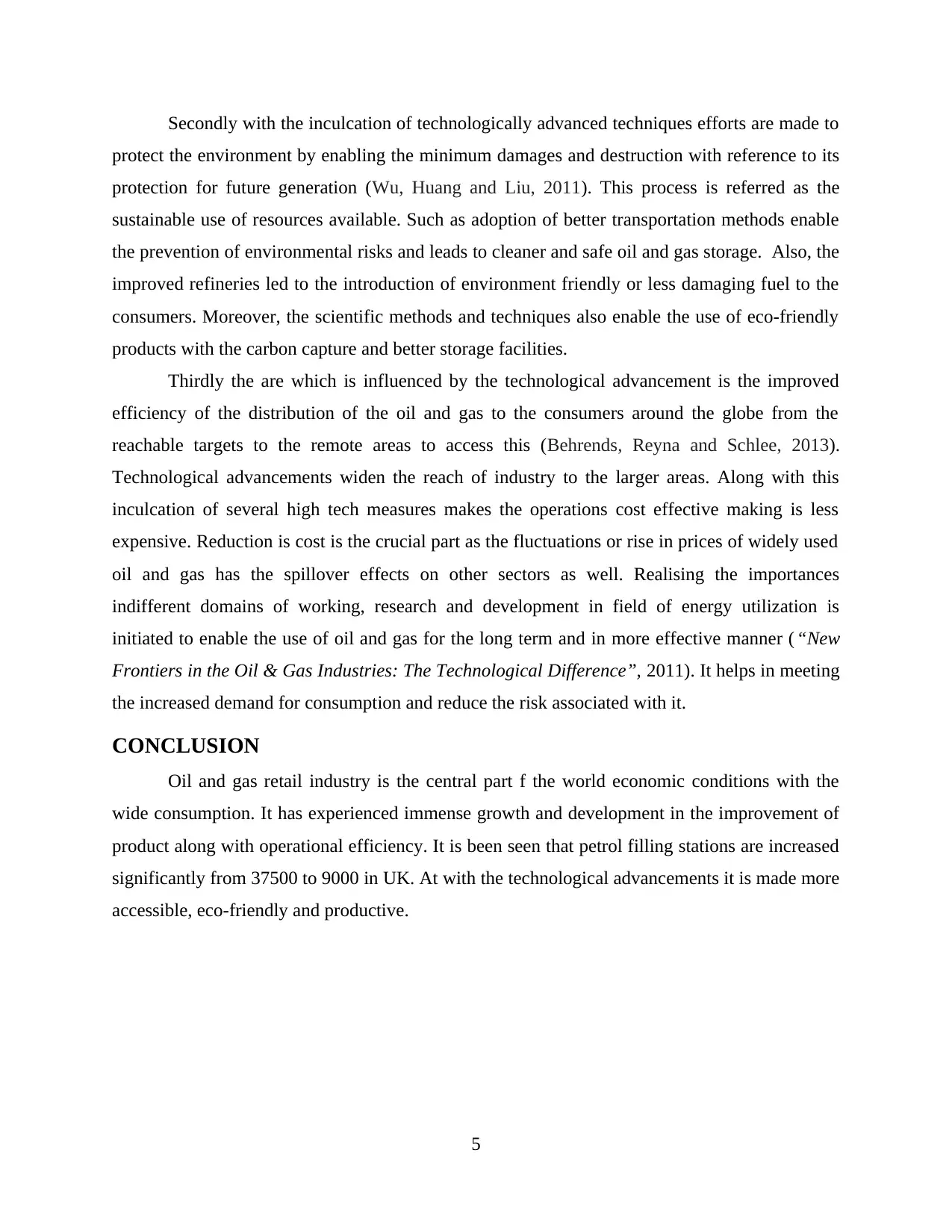
Secondly with the inculcation of technologically advanced techniques efforts are made to
protect the environment by enabling the minimum damages and destruction with reference to its
protection for future generation (Wu, Huang and Liu, 2011). This process is referred as the
sustainable use of resources available. Such as adoption of better transportation methods enable
the prevention of environmental risks and leads to cleaner and safe oil and gas storage. Also, the
improved refineries led to the introduction of environment friendly or less damaging fuel to the
consumers. Moreover, the scientific methods and techniques also enable the use of eco-friendly
products with the carbon capture and better storage facilities.
Thirdly the are which is influenced by the technological advancement is the improved
efficiency of the distribution of the oil and gas to the consumers around the globe from the
reachable targets to the remote areas to access this (Behrends, Reyna and Schlee, 2013).
Technological advancements widen the reach of industry to the larger areas. Along with this
inculcation of several high tech measures makes the operations cost effective making is less
expensive. Reduction is cost is the crucial part as the fluctuations or rise in prices of widely used
oil and gas has the spillover effects on other sectors as well. Realising the importances
indifferent domains of working, research and development in field of energy utilization is
initiated to enable the use of oil and gas for the long term and in more effective manner ( “New
Frontiers in the Oil & Gas Industries: The Technological Difference”, 2011). It helps in meeting
the increased demand for consumption and reduce the risk associated with it.
CONCLUSION
Oil and gas retail industry is the central part f the world economic conditions with the
wide consumption. It has experienced immense growth and development in the improvement of
product along with operational efficiency. It is been seen that petrol filling stations are increased
significantly from 37500 to 9000 in UK. At with the technological advancements it is made more
accessible, eco-friendly and productive.
5
protect the environment by enabling the minimum damages and destruction with reference to its
protection for future generation (Wu, Huang and Liu, 2011). This process is referred as the
sustainable use of resources available. Such as adoption of better transportation methods enable
the prevention of environmental risks and leads to cleaner and safe oil and gas storage. Also, the
improved refineries led to the introduction of environment friendly or less damaging fuel to the
consumers. Moreover, the scientific methods and techniques also enable the use of eco-friendly
products with the carbon capture and better storage facilities.
Thirdly the are which is influenced by the technological advancement is the improved
efficiency of the distribution of the oil and gas to the consumers around the globe from the
reachable targets to the remote areas to access this (Behrends, Reyna and Schlee, 2013).
Technological advancements widen the reach of industry to the larger areas. Along with this
inculcation of several high tech measures makes the operations cost effective making is less
expensive. Reduction is cost is the crucial part as the fluctuations or rise in prices of widely used
oil and gas has the spillover effects on other sectors as well. Realising the importances
indifferent domains of working, research and development in field of energy utilization is
initiated to enable the use of oil and gas for the long term and in more effective manner ( “New
Frontiers in the Oil & Gas Industries: The Technological Difference”, 2011). It helps in meeting
the increased demand for consumption and reduce the risk associated with it.
CONCLUSION
Oil and gas retail industry is the central part f the world economic conditions with the
wide consumption. It has experienced immense growth and development in the improvement of
product along with operational efficiency. It is been seen that petrol filling stations are increased
significantly from 37500 to 9000 in UK. At with the technological advancements it is made more
accessible, eco-friendly and productive.
5
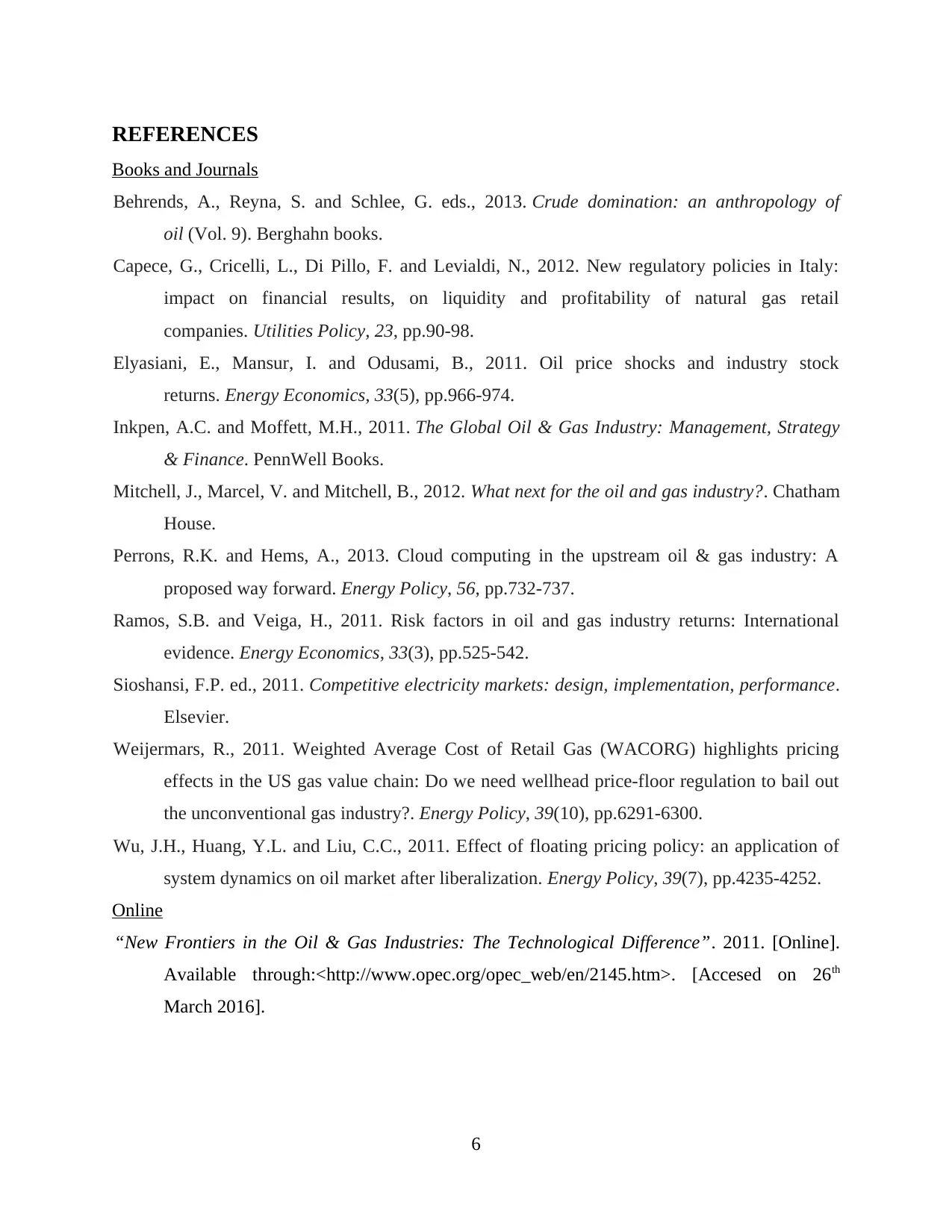
REFERENCES
Books and Journals
Behrends, A., Reyna, S. and Schlee, G. eds., 2013. Crude domination: an anthropology of
oil (Vol. 9). Berghahn books.
Capece, G., Cricelli, L., Di Pillo, F. and Levialdi, N., 2012. New regulatory policies in Italy:
impact on financial results, on liquidity and profitability of natural gas retail
companies. Utilities Policy, 23, pp.90-98.
Elyasiani, E., Mansur, I. and Odusami, B., 2011. Oil price shocks and industry stock
returns. Energy Economics, 33(5), pp.966-974.
Inkpen, A.C. and Moffett, M.H., 2011. The Global Oil & Gas Industry: Management, Strategy
& Finance. PennWell Books.
Mitchell, J., Marcel, V. and Mitchell, B., 2012. What next for the oil and gas industry?. Chatham
House.
Perrons, R.K. and Hems, A., 2013. Cloud computing in the upstream oil & gas industry: A
proposed way forward. Energy Policy, 56, pp.732-737.
Ramos, S.B. and Veiga, H., 2011. Risk factors in oil and gas industry returns: International
evidence. Energy Economics, 33(3), pp.525-542.
Sioshansi, F.P. ed., 2011. Competitive electricity markets: design, implementation, performance.
Elsevier.
Weijermars, R., 2011. Weighted Average Cost of Retail Gas (WACORG) highlights pricing
effects in the US gas value chain: Do we need wellhead price-floor regulation to bail out
the unconventional gas industry?. Energy Policy, 39(10), pp.6291-6300.
Wu, J.H., Huang, Y.L. and Liu, C.C., 2011. Effect of floating pricing policy: an application of
system dynamics on oil market after liberalization. Energy Policy, 39(7), pp.4235-4252.
Online
“New Frontiers in the Oil & Gas Industries: The Technological Difference”. 2011. [Online].
Available through:<http://www.opec.org/opec_web/en/2145.htm>. [Accesed on 26th
March 2016].
6
Books and Journals
Behrends, A., Reyna, S. and Schlee, G. eds., 2013. Crude domination: an anthropology of
oil (Vol. 9). Berghahn books.
Capece, G., Cricelli, L., Di Pillo, F. and Levialdi, N., 2012. New regulatory policies in Italy:
impact on financial results, on liquidity and profitability of natural gas retail
companies. Utilities Policy, 23, pp.90-98.
Elyasiani, E., Mansur, I. and Odusami, B., 2011. Oil price shocks and industry stock
returns. Energy Economics, 33(5), pp.966-974.
Inkpen, A.C. and Moffett, M.H., 2011. The Global Oil & Gas Industry: Management, Strategy
& Finance. PennWell Books.
Mitchell, J., Marcel, V. and Mitchell, B., 2012. What next for the oil and gas industry?. Chatham
House.
Perrons, R.K. and Hems, A., 2013. Cloud computing in the upstream oil & gas industry: A
proposed way forward. Energy Policy, 56, pp.732-737.
Ramos, S.B. and Veiga, H., 2011. Risk factors in oil and gas industry returns: International
evidence. Energy Economics, 33(3), pp.525-542.
Sioshansi, F.P. ed., 2011. Competitive electricity markets: design, implementation, performance.
Elsevier.
Weijermars, R., 2011. Weighted Average Cost of Retail Gas (WACORG) highlights pricing
effects in the US gas value chain: Do we need wellhead price-floor regulation to bail out
the unconventional gas industry?. Energy Policy, 39(10), pp.6291-6300.
Wu, J.H., Huang, Y.L. and Liu, C.C., 2011. Effect of floating pricing policy: an application of
system dynamics on oil market after liberalization. Energy Policy, 39(7), pp.4235-4252.
Online
“New Frontiers in the Oil & Gas Industries: The Technological Difference”. 2011. [Online].
Available through:<http://www.opec.org/opec_web/en/2145.htm>. [Accesed on 26th
March 2016].
6
⊘ This is a preview!⊘
Do you want full access?
Subscribe today to unlock all pages.

Trusted by 1+ million students worldwide
1 out of 9
Related Documents
Your All-in-One AI-Powered Toolkit for Academic Success.
+13062052269
info@desklib.com
Available 24*7 on WhatsApp / Email
![[object Object]](/_next/static/media/star-bottom.7253800d.svg)
Unlock your academic potential
Copyright © 2020–2025 A2Z Services. All Rights Reserved. Developed and managed by ZUCOL.





